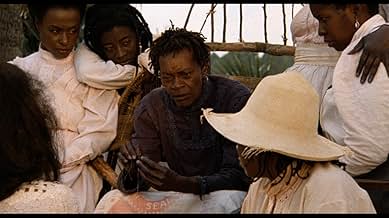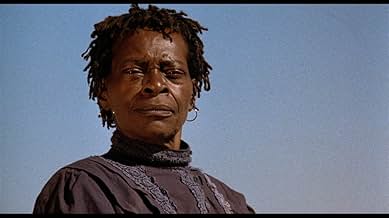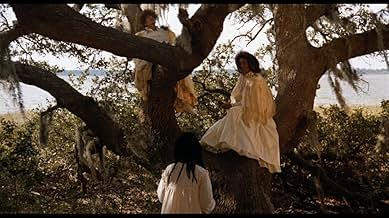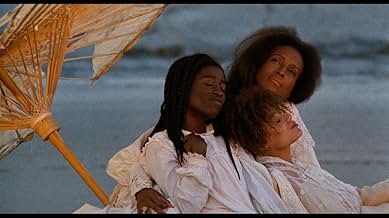NOTE IMDb
6,6/10
3,6 k
MA NOTE
Ajouter une intrigue dans votre langueA languid, impressionistic story of three generations of Gullah women living on the South Carolina Sea Islands in 1902.A languid, impressionistic story of three generations of Gullah women living on the South Carolina Sea Islands in 1902.A languid, impressionistic story of three generations of Gullah women living on the South Carolina Sea Islands in 1902.
- Réalisation
- Scénario
- Casting principal
- Récompenses
- 4 victoires et 2 nominations au total
Barbara O
- Yellow Mary
- (as Barbara-O)
Tony King
- Newlywed Man
- (as Malik Farrakhan)
Avis à la une
Daughters of The Dust was produced by Geechee Girls and American Playhouse Company. The movie main focus is on the Peazant women. Nana Peazant is played by Cora Lee Day, and Eula, her granddaughter, is played by Alva Rogers who is pregnant and has been raped by a landowner. Nana's granddaughter, Yellow Mary, is played by Barbara-O who is returning, with her friend Trula, from the mainland and her life as a prostitute and wet nurse. Haggar, who has married into the family, is played by Kaycee Moore and wants nothing to do with the old traditions. Similarly, the Christian Viola, played by Cheryl Lynn Bruce, is returning from her life on the mainland.
Daughters of the Dust is a film written and directed by Julie Dash. It tells the story of a family of African-Americans who have lived for many years on a Southern offshore island, and of how they come together one day in 1902 to celebrate their ancestors before some of them leave for the North. The film is narrated by an unborn child, and ancestors already dead also seem to be as present as the living.
Julie Dash underwent many hardships in bringing the story to the silver screen. She had severe budget constraints, filmed in mosquito and insect infested areas, was delayed by Hurricane Hugo, sidetracked by sudden and violent sandstorms, and was forced to decide to either have a child or make the movie. In the end, she choose to give birth and nurture the story Daugthers of the Dust and the result is an unconventional masterpiece.
Initially, the response by white male critics was not favorable and they accused Dash of not adequately explaining the Gullah people, their culture, and their religious traditions. While attacking Dash, these critics failed to acknowledge many positive aspects of the film. The reasons behind this, according to Bell Hooks, is that "we've never been taught, most of us, in any history class that black people had different languages, had different religious practices, etc. So, to some extent, the film represents that challenge to a critic of any race" to review something they are not familiar with.
Because of these reviews and the fact that movie tells the story of African American women in an unconventional manner, it would seem to have slim commercial prospects. However, through word of mouth and some positive reviews it was able to generate a cult following. To date, the film has grossed 1.6 million from a budget of only 800,000.
The Newark Black Film Festival has chosen Daughters as the Film of The Century while the British Film Institute's Sight and Sound Magazine chose the soundtrack as one of the best in the past 25 years. It also received the Best Cinematography award at the Sundance Film Festival in 1991.
I believe the film hits the viewer on various levels. By placing the story in the early 1900's, Dash is able to show us a turbulent time for African-Americans and address many issues such as migration, lynching, and the changing African-American culture. Dash also shows and teaches us about Ibo culture and it's importance in the lives of those inhabiting the Sea Coast Islands, not just the African-Americans sharing the Gullah culture, but also the Native Americans, Muslims, and Christians.
Daughters of the Dust is a film written and directed by Julie Dash. It tells the story of a family of African-Americans who have lived for many years on a Southern offshore island, and of how they come together one day in 1902 to celebrate their ancestors before some of them leave for the North. The film is narrated by an unborn child, and ancestors already dead also seem to be as present as the living.
Julie Dash underwent many hardships in bringing the story to the silver screen. She had severe budget constraints, filmed in mosquito and insect infested areas, was delayed by Hurricane Hugo, sidetracked by sudden and violent sandstorms, and was forced to decide to either have a child or make the movie. In the end, she choose to give birth and nurture the story Daugthers of the Dust and the result is an unconventional masterpiece.
Initially, the response by white male critics was not favorable and they accused Dash of not adequately explaining the Gullah people, their culture, and their religious traditions. While attacking Dash, these critics failed to acknowledge many positive aspects of the film. The reasons behind this, according to Bell Hooks, is that "we've never been taught, most of us, in any history class that black people had different languages, had different religious practices, etc. So, to some extent, the film represents that challenge to a critic of any race" to review something they are not familiar with.
Because of these reviews and the fact that movie tells the story of African American women in an unconventional manner, it would seem to have slim commercial prospects. However, through word of mouth and some positive reviews it was able to generate a cult following. To date, the film has grossed 1.6 million from a budget of only 800,000.
The Newark Black Film Festival has chosen Daughters as the Film of The Century while the British Film Institute's Sight and Sound Magazine chose the soundtrack as one of the best in the past 25 years. It also received the Best Cinematography award at the Sundance Film Festival in 1991.
I believe the film hits the viewer on various levels. By placing the story in the early 1900's, Dash is able to show us a turbulent time for African-Americans and address many issues such as migration, lynching, and the changing African-American culture. Dash also shows and teaches us about Ibo culture and it's importance in the lives of those inhabiting the Sea Coast Islands, not just the African-Americans sharing the Gullah culture, but also the Native Americans, Muslims, and Christians.
Daughters of the Dust is film that slits the eyes of spectators who have been fed only linear and simplistic narrative/plot dev'ts through hollywoodism and can't possibly fathom any other way of being/thinking. It is truly an excruciating film to watch for those who have not dreamt and lived the "double consciousness" of modernity, for those who do NOT want to recall and remember the fact of american quilombos, maroon societies, slave revolters and runaways who succesfully established another way of life, not based on european dominance. This story is about the struggles of maintaining that community in 1902, a turning point in the life of this one maroon society. Dash breaks with cinematic codes in her experimental reconstruction of historical memory...a forgotten episode in African american history, a forgotten place, re-calling back to life ancestors that had survived and thrived: The Gullahs, Peazant family, persisting, unerasable, as the unborn child running through our memory, coming out of our past, forging a new and alternative future: a future that rejects the limitations of western epistemology. The summoning of these images to screen from the unwritten (african) past provides its own logic and development which Dash successfully visualizes in a polyphonic tradition, many voices, multiple perspectives. She does not allow a simplistic and individualistic rendering of this history...NO!she allows the struggle of divergent african perspectives, Christian, Muslim, Africanist, Native American to emerge in the same frame, to address that age old question: To exist or not to exist, to bear witness or to forget. In order for this history to exist and bear witness, Julie Dash does not allow any conventional reductionary scheme of narrativity, her temporal references are not linear. Her story is told through palimpestic time, the past present and future, overlapping and disjunctive: rupturing our understanding of history/memory and identity. The conflict that drives the film's narrative is not individual ego/conventional good vs bad drama/or boy gets girl(Hollywoodism); the conflict is how will the communal memory of these African survivors be salvaged from the ravaging of modernism's erasure..We see the family eat their last supper as the rite of passage to a life on the other side, a side that the ancestors fought to diverge from...The film is testimony to the african ancestors and to the spirit of resistance of slave revolters. Many people have offered criticism of dash's "feminism." Feminism is a problematic concept to apply to this film, no it is not feminist, it is afro-centric, matri-focal, and woman, as bearer of culture and memory as mother to the community, becomes the embodiment of that struggle. (of course it is not "feminist": it doesn't speak about abortion law, equal pay, etc etc..this kind of feminism is eurocentric and simplistic..) Thank you Julie Dash, i am not african american but the tears poured down my face as i, too, recalled that life left behind, another time another place. A place where people, muslims/christians/indigenous or any other can actually co-exist peacefully side by side, respectful of each other's differences. The character who chose to leave her so called "civilized" mother at the last minute, to take off with her Native American lover..is one of the most powerful onscreen testimony of love between indigenous peoples that has ever been made.
I really wanted to like this, but other than visually, there wasn't much to appreciate. A stronger storyline would have been nice.
It does however inspire me to visit the area and look into the history, but I wish the movie itself had told me more.
Kudos for the effort.
It does however inspire me to visit the area and look into the history, but I wish the movie itself had told me more.
Kudos for the effort.
Daughters of the Dust directed by Julie Dash is a cultural perspective look into the lives of an African American family left on an island years after being torn from their heritage of Africa for slavery only to have revolted and be left to themselves, stranded on the island off the coast of the Southern eastern coast and the family who live off the island with others who long to find their heritage. The film's story line is developed in the one day where the family is getting ready to head to a new world on the main land. The internal conflict of the family between relatives who no longer live on the island who have become part of the culture of America post civil war and the family left on the island that live by the old heritage and customs. The family on the island struggle between their history and culture to the change of the times and the need for conformity. This film centers on the generations of the family from the young children who are filled with life then to the adults who are torn between their decisions to leave to finally the center character, the elder grandmother of the family Nana. Nana's ways and beliefs that have been accepted by the family their entire lives are now the only thing holding the family back from their future off the island. The film focuses largely on the women of the family, displaying the differences of ones who that have lived on the island and then those whom have lived off it. The lines divided between the two are evidently shown throughout the film. The women who lived off the island no longer take to heart their heritage that Nana lives by. They find it to be uncivilized and against the teaching of the bible. There is the scene in which the family after much struggle and torment accept Nana's decision to stay and her heritage. The scene is of the entire family gathered around the grandmother in which she has a lock of her hair and others placed on a bible asking everyone to believe in the old ways and take her with her by kissing the hair and bible. Finally, the scene acts as importance because one of the outside family members whom diligently preaches and believes in Christianity gives in to Nana's request.
Daughters of the Dust cannot be explained without stating the mise en cinema. From the clothing to the shots of the landscape of the island all resemble the time and place of the film. Not only the background and clothes, but also the character themselves turn this limited distributed film into a believable representation of what people of this time would act and be. The storyline background of the slavery uprising actually having taken place on the island gives it enormous creditability. The shots of the island start the creditability of the film with shots of the women interacting with the water of the ocean and the rivers, the shots of the forest and trees, and finally the most significant may be when the women are preparing the dinner showing how their food is prepared with live seafood and spices gathered from the island. The mise en cinema is creditable because of the clothes as well; from Nana who has only a dress is indigo, which was the main produce to harvest by the slaves on the island to the white Victorian dress of the women from the main land.
Dash's Daughters of the Dust cannot be denied as a cultural perspective that's originality has touched on the transition to the new culture of African Americans and they past that many have forgotten after the postwar civil war era. Its cultural insight may have been directed to a certain selected target audience, but its look into the heritage of the people cannot be viewed as anything but a respectable insight of the times.
Daughters of the Dust cannot be explained without stating the mise en cinema. From the clothing to the shots of the landscape of the island all resemble the time and place of the film. Not only the background and clothes, but also the character themselves turn this limited distributed film into a believable representation of what people of this time would act and be. The storyline background of the slavery uprising actually having taken place on the island gives it enormous creditability. The shots of the island start the creditability of the film with shots of the women interacting with the water of the ocean and the rivers, the shots of the forest and trees, and finally the most significant may be when the women are preparing the dinner showing how their food is prepared with live seafood and spices gathered from the island. The mise en cinema is creditable because of the clothes as well; from Nana who has only a dress is indigo, which was the main produce to harvest by the slaves on the island to the white Victorian dress of the women from the main land.
Dash's Daughters of the Dust cannot be denied as a cultural perspective that's originality has touched on the transition to the new culture of African Americans and they past that many have forgotten after the postwar civil war era. Its cultural insight may have been directed to a certain selected target audience, but its look into the heritage of the people cannot be viewed as anything but a respectable insight of the times.
I saw this film for a film class at UF. We have seen some slow and some fast-paced films. This is by far the slowest we have seen and is the most boring piece of cinema I have ever seen.
Now, it's not ALL bad. The movie has some cultural significance and was obviously researched before filming. The shot selection was very good, colors vibrant, and you could feel the actors' emotions.
But the story... was slow. There's a load of characters and I couldn't figure out who was related to who and what all had happened with the pregnant woman. The movie was like the opening title-card sequence to Black Hawk Down stretched out to 2 hours in length. There's parts with loads of music and no dialogue and vice versa. The movie seemed to reach an ending 5 times before it finally did. The writer-director clearly had no clue as to what pacing was.
The story was basically about some African-Americans at the turn of the century who boat down to their family on the shores of some island that is separated on one side by a river and the ocean on the other. They want a better life and are split about whether the island or the mainland is the better spot for it. It takes them two agonizing (to us) hours to decide.
Long [very long] story short: half the class walked out in the first hour. And I was jealous of those who did when I reached the end of the film. 2/10
Now, it's not ALL bad. The movie has some cultural significance and was obviously researched before filming. The shot selection was very good, colors vibrant, and you could feel the actors' emotions.
But the story... was slow. There's a load of characters and I couldn't figure out who was related to who and what all had happened with the pregnant woman. The movie was like the opening title-card sequence to Black Hawk Down stretched out to 2 hours in length. There's parts with loads of music and no dialogue and vice versa. The movie seemed to reach an ending 5 times before it finally did. The writer-director clearly had no clue as to what pacing was.
The story was basically about some African-Americans at the turn of the century who boat down to their family on the shores of some island that is separated on one side by a river and the ocean on the other. They want a better life and are split about whether the island or the mainland is the better spot for it. It takes them two agonizing (to us) hours to decide.
Long [very long] story short: half the class walked out in the first hour. And I was jealous of those who did when I reached the end of the film. 2/10
Le saviez-vous
- AnecdotesSelected to the Library of Congress National Registry of Film in 2004.
- Citations
[first lines]
Nana Peazant: I am the first and the last. I am the honored one and the scorned one. I am the whore and the holy one. I am the wife and the virgin. I am the barren one and many are my daughters. I am the silence that you can not understand. I am the utterance of my name.
Meilleurs choix
Connectez-vous pour évaluer et suivre la liste de favoris afin de recevoir des recommandations personnalisées
- How long is Daughters of the Dust?Alimenté par Alexa
Détails
- Date de sortie
- Pays d’origine
- Langues
- Aussi connu sous le nom de
- Дочери пыли
- Lieux de tournage
- Sociétés de production
- Voir plus de crédits d'entreprise sur IMDbPro
Box-office
- Montant brut aux États-Unis et au Canada
- 1 683 422 $US
- Week-end de sortie aux États-Unis et au Canada
- 10 842 $US
- 20 nov. 2016
- Montant brut mondial
- 1 689 776 $US
- Durée
- 1h 53min(113 min)
- Couleur
- Rapport de forme
- 1.85 : 1
Contribuer à cette page
Suggérer une modification ou ajouter du contenu manquant






























